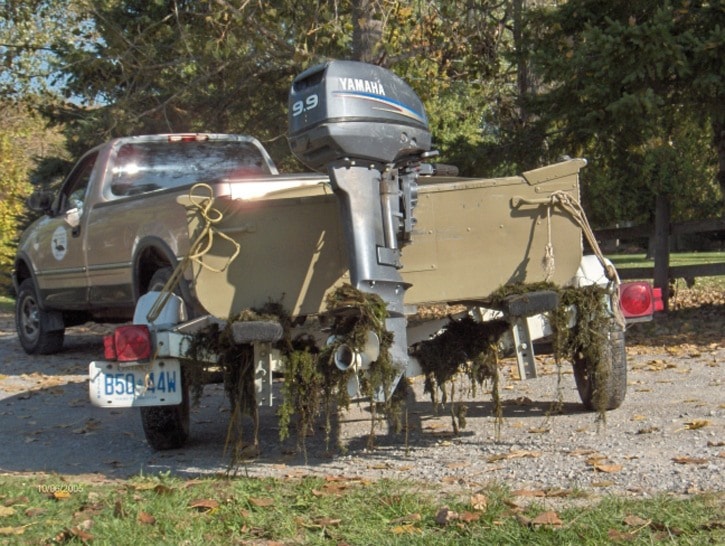Far from science fiction or ‘what if’ scenarios, a trio of highly invasive non-native hitchhiking aquatic plant and animal species of the most inimical kind is a real threat to Arrow and area waters and cause for growing concern.
What makes each of the three so dangerous is that they all share certain traits not common to any other species known. Originating from opposite corners of the globe, and needing only a drop of moisture to survive for up to thirty days is phenomenal in itself. This feature enables the species to travel great distances over both water and land by attaching themselves to all classes of ships, boats, boating equipment, trailers, water toys, fishing equipment and even hip waders, especially the soft felts.
That’s the word from the professional scientific community and that is how the species spread: we, the boating and fishing enthusiasts move them from an infected body of water to infect the next water body. The real threat is that once introduced, they grow extremely fast, cannot be eradicated or controlled in most instances, and are extremely expensive to cope with. An infestation would have a negative impact on society, the local economy, and alter the ecosystem of the Arrow Lakes environment forever ... should they get here.
The first of the trio originates from the Baltic, and is an animal known to have entered the now contaminated Great Lakes in the ‘80s: the tiny zebra and quagga mussel. The only thumbnail to microscopic-sized fresh water mollusk capable of attaching and colonizing onto any hard surface has since managed to infect the entire Mississippi watershed, and all states west of the continental divide except Washington, Idaho, Montana Oregon and Wyoming. In Canada, Manitoba is on high alert due to zebra larvae found in North Dakota’s Red River.
For the time being, B.C. is free of the invader, thanks to our southern neighbours’ commitment to establish watercraft inspection and decontamination stations in their effort to stop the spread. The state of Idaho for example has 15 manned mandatory inspection stations and since 2007, several infected boats headed for B.C. and Alberta waters were disinfected before leaving their state – the most recent being in February of 2012.
These mussels smother out native plants and organisms by large colonization and change ecosystems and food source critical to fish survival. As filter feeders, they accumulate pollutants in their tissue thereby polluting the fish and ducks that eat the mussels. The bivalves also colonize boats, engines, docks, clog water-intake systems and power plants, dams, locks, utilities, boat launches and marinas, and litter beaches with sharp smelly shells. Colonization density by the way is swift – somewhere in the 700,000 per square metre, or 17,800 per square inch, in the first year from just a few critters.
The second set of the trio, the more familiar Eurasian Watermilfoil (EW) and its close relative Hydrilla, is easily spread by fragmentation and originates from Europe and Asia. A submersed aquatic perennial plant, it grows surface-bound as dense mats. Famous in the Okanagan Lake since the ‘70s for its annual mowing events, it has since spread to other valley lakes: Shuswap, Mara, Christina, Champion, Nicola. It can also be found in the lower mainland, Vancouver Island, Idaho, Washington, Columbia and Kootenay Rivers, and many sites around Kootenay Lake.
EW is a great breeding ground for mosquitoes, provides no food source and is a poor habitat for waterfowl, fish and other wildlife. Decomposition decreases water quality so critical for other aquatic species and can negatively impact generation and irrigation systems by clogging dam trash racks and intake pipes. How fast can it spread? In 1965, a 40-hectare monostand was discovered in a lake in North Carolina. Nine years later the monostand consumed 32,000 hectares – an astonishing 3 and a half square kilmetres per season.
Didymosphenia – or Didymo for short, is an invasive alga native to northern Europe and North America. It takes only one single cell to attach to a rock in a creek bed to establish a colony of ‘rock snot,’ aptly named for its ability to cling to rocks and look like...underwater toilet paper. Small thick brown bubbles grow on rocks creating extensive white, beige or brown carpets within a matter of a three month spring bloom, and can cover moderate to high flow shallow creeks or lake bottoms for several kilometres.
With no known ill effects to human, this stuff appears slimy but feels like wet cotton or scratchy wool. Fish populations experience reduction in preferred food supplies and rearing habitats, gill irritation and depleted dissolved oxygen – most critical for fish survival.
Sport fishing in contaminated waters becomes almost impossible as the alga attaches itself to lures and lines. Felt-soled waders worn by stream anglers as well as all watercraft are considered pathways for Didymo spread and, as a single cell can survive up to 30 days in one drop of water, it is for this reason that felt-soled waders have been banned in many U.S. states.
Confirmed infected areas in B.C. include Vancouver Island (since the 1980s), Bulkley, South Thompson, Kettle, Columbia and Kootenay Rivers, and more recently St. Mary near Kimberly, Shuswap River near Cherryville, as well as Rosebery’s Wilson Creek and neighbouring Carpenter Creek.
So what’s being done, if anything, to stop the invaders from spreading into the Arrow region? Answers to this and many other questions will be dealt with in part 2.
